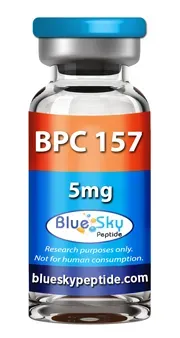35% Off Your Order*
Save Now!!

Availability: In stock

| Unit Size | 5 mg/vial |
| Unit Quantity | 1 vial |
| Purity (Mass Spectrometry and UV) | 99.75% |
| Sequence | H-Gly-Glu-Pro-Pro-Pro-Gly-Lys-Pro-Ala-Asp-Asp-Ala-Gly-Leu-Val-OH |
| Molecular Formula | C62H98N16O22 |
| Appearance | Lyophilized White Powder |
| Source | Chemical Synthesis |
| Storage | Lyophilized BPC 157 is Stable at room Temperature for 90 days, however it is best to store in a freezer below - 8c for any extended period of time. |
| Terms | The products we offer are intended for laboratory research use only. Please familiarize yourself with our terms of service prior to ordering. |
Body Protection Compound-157 (BPC-157) is a synthetic peptide derived from a sequence of 15 amino acids originally isolated from human gastric juices. Known for its potential to protect gastrointestinal tissue and enhance wound healing, BPC-157 has been widely studied in *in vitro* laboratory research for its biological activity and protective properties.
Research-Driven Applications of BPC-157 in In Vitro Studies
1. Wound Healing and Tissue Repair: One of the primary focuses of *in vitro* studies on BPC-157 is its ability to promote wound healing and facilitate tissue regeneration. BPC-157 has shown the capacity to stimulate fibroblast and collagen production, essential processes in wound closure and scar formation.(1) This peptide also enhances the migration of fibroblasts to wound sites, supporting cellular regeneration in tissue repair.(2) These properties make BPC-157 relevant for *in vitro* studies exploring therapeutic approaches to skin injuries and soft tissue damage.
2. Gastrointestinal Protection: BPC-157 is noted for its gastroprotective properties, helping prevent gastric ulcer formation and supporting intestinal cell integrity. *In vitro* research suggests that BPC-157 may stabilize gastric cell walls and prevent cell death in digestive tract models exposed to high levels of acid or harmful agents.(3) This has led to increased interest in using BPC-157 as a model compound for studying gastrointestinal disorders like Crohn’s disease, irritable bowel syndrome (IBS), and other inflammatory conditions affecting the GI tract.(4)
3. Vascular Growth and Angiogenesis: BPC-157 has shown promising results in *in vitro* studies examining its role in vascular growth and angiogenesis. It appears to promote the formation of new blood vessels by upregulating the expression of vascular endothelial growth factor (VEGF) in endothelial cells, which is essential for tissue repair and regeneration.(5) This property makes BPC-157 a valuable compound for studying wound healing, tissue recovery, and regenerative medicine approaches.
4. Anti-Inflammatory and Oxidative Stress Resistance: Studies indicate that BPC-157 exhibits antioxidant and anti-inflammatory effects in *in vitro* settings, which may help protect cells from oxidative damage. By reducing the production of reactive oxygen species (ROS) and lowering inflammatory cytokines in cell cultures, BPC-157 contributes to maintaining cellular health in oxidative and inflammatory conditions.(6) These findings are valuable for research into diseases and injuries where inflammation and oxidative stress play a significant role.
5. Tendon and Muscle Repair: BPC-157 has been studied for its potential to support tendon and muscle repair. In *in vitro* models, BPC-157 increased the rate of collagen production and supported the healing of damaged tendon fibers by encouraging fibroblast proliferation.(7) This aspect of BPC-157 is of particular interest for studies focused on sports injuries and musculoskeletal disorders, where cellular regeneration is critical.
It is crucial to emphasize that BPC-157 is provided exclusively for in vitro laboratory research purposes. This peptide is not intended for human or veterinary use, and any application outside of controlled *in vitro* environments is prohibited. Research using BPC-157 must be conducted under controlled laboratory conditions to explore its effects on cellular and molecular mechanisms. Ingestion or use in clinical contexts is strictly prohibited.
Our BPC-157 is formulated with a density of 2%, optimized for effective signaling efficiency in *in vitro* research applications. This ensures consistent performance in laboratory studies and helps researchers explore the full potential of BPC-157 in a controlled research setting.
References